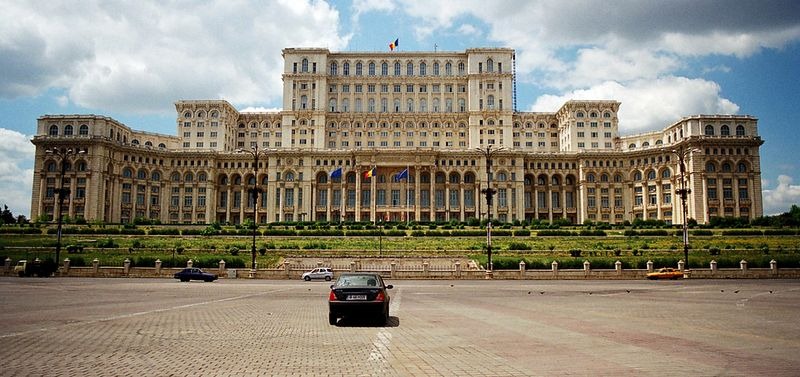At the historical center of Romania’s capital city Bucharest, stands the colossal Palace of the Parliament, one of the most expensive and extravagant building project undertaken in the last century. Regarded as the crowning jewel of the megalomaniac Romanian dictator Nicolae Ceausescu’s ambitious urban development plan, and an embarrassment for its citizens, the Palace was built at great human and economic costs. To build the House of the Republic, the dictator leveled an entire hill and wiped out one fifth of the historic center of Bucharest. The project consumed a third of Romania's budget over 5 years. Despite being the object of disdain, it is Bucharest’s most visited tourist attraction.

Photo credit: Alejandro Giacometti/Flickr
The Palace of the Parliament claims many superlatives —it is the second largest administrative building in the world, after The Pentagon in the United States; the third most massive building in the world, after the Vehicle Assembly Building at Kennedy Space Center in Florida and the Mexican Pyramid of the Feathered Serpent in Teotihuacan; and the heaviest building in the world. At USD 4 billion, it is also the most expensive administrative building in the world. The cost of heating and electric lighting alone exceeds $6 million per year, as much as a medium-sized city.
The idea for the Palace of the Parliament, originally called “The People's House”, took root in Ceausescu’s mind after a visit to North Korea's Kim II-sung in 1972. Impressed by how his fellow dictator had built Pyongyang, Ceausescu started making plans for the most lavish palace in the world that would hold all the functions of his socialist state, aside from serving as a handsome residence for him and his wife. After a devastating earthquake in 1977 leveled Bucharest, Ceausescu seized the opportunity and decided to completely rebuild the city in his own vision.
To accommodate his massive plans, Ceausescu demolished most of Bucharest's historic districts including more than two dozen churches, synagogues and temples, numerous factories and hospitals, and hundreds of homes. Some 40,000 people were forcibly relocated. One-fifth of central Bucharest was razed to the ground including a hill.
Photo credit: Nico Trinkhaus/Flickr
Construction began in 1984. Between 20,000 and 100,000 workers toiled in 24-hour shifts, seven days a week. To finance the project, Ceausescu took an enormous foreign debt which he repaid by exporting all of the country's agricultural and industrial production while the Romanian people starved and the standard of living sank to an all time low. Some 3,000 people were reported to have died.
A young architect named Anca Petrescu (named by BBC as the “worst architect in the world”) was appointed chief architect of the project. Anca, who was only 28 years at that time, collaborated with nine other architects and some 700 subordinates on the building’s design which combines elements and motifs from a multitude of classical sources. The palace is 240 meters long, 270 meters wide and 12 stories tall. There are eight underground levels with the last one designed to serve as an anti-nuclear bunker for Ceausescu’s family, in the event of a nuclear war.
Inside the palace there are 1,100 rooms with total floor area of 365,000 square meters. 900,000 cubic meters of wood was used for parquet and wainscoting, 1 million cubic meters of marble, and 200,000 square meters of woven carpets. 3,500 metric tones of crystal was consumed to manufacture 480 chandeliers.
By December 1989, the building was only two-thirds complete, when Romania erupted in a revolution and Ceausescu had to escape the capital by a helicopter. He was later captured and executed by firing squad.
The building was eventually completed in 1994. It now houses the Romanian Senate and Chamber of Deputies, and a modern art museum which occupies the ground floor. 70% of the building still remains empty.

Photo credit: yk poon/Flickr
Photo credit: Dennis Jarvis/Flickr
Photo credit: Dennis Jarvis/Flickr
Photo credit: Dennis Jarvis/Flickr
Photo credit: Dennis Jarvis/Flickr
Photo credit: Dennis Jarvis/Flickr
Photo credit: Anders Sandberg/Flickr
Photo credit: Antoine Collet/Flickr
Photo credit: Gaspar Serrano/Flickr
Sources: www.local-life.com / CNN / Wikipedia





















Comments
Post a Comment